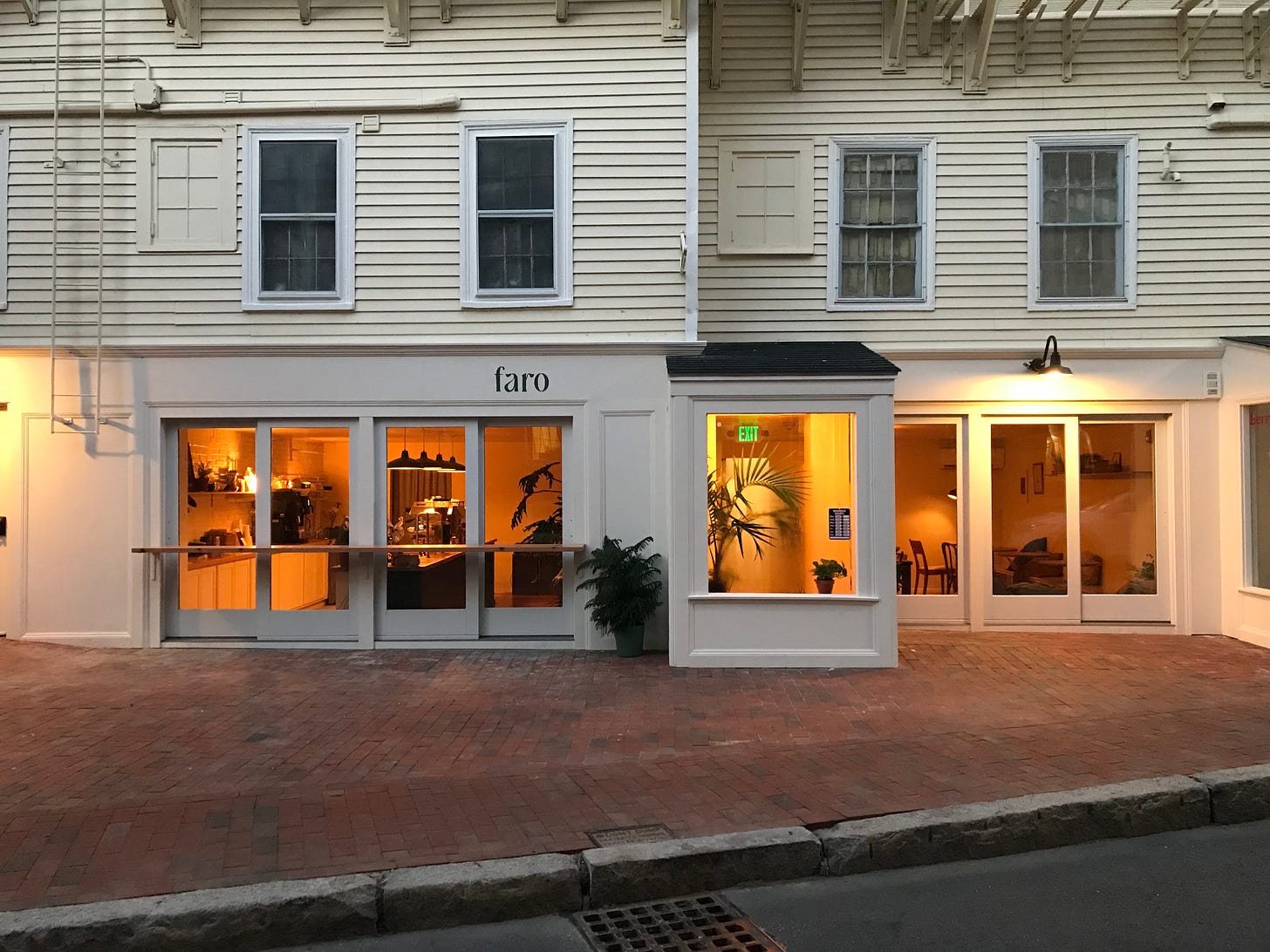the city and the limiting virtues
"freedom to" and "freedom from" in the cafe, church, and library
This is undefended / undefeated, a newsletter by Sara Hendren on design, education, disability, technology, and related ideas. At some point you signed up for it; to unsubscribe, head to the bottom of this post. For my subscribers using screenreaders and others who love audio: I’ve got a voiced version of this post just below this paragraph — let me know if your software is not able to locate it. And the alt text edit function isn’t working, so I’ve got image descriptions in audio and in the captions this time.
Faro café, in Harvard Square, gets its name from the Spanish word for “lighthouse,” and it’s got a no-laptops policy that is gently, but strictly, enforced.

You can look at your phone. You can use a little gaming tablet. But they’ve outlawed laptops — upright and rectangular cognitive anchors that suck all energy toward themselves. Multiplied across a room, laptops erect an office where a café had been. And Faro is trying to keep the office at bay.
But the office-style café is really great, you say. It is! You can go a few doors down in a couple directions and find some good ones. But Faro has their little manifesto printed and hung on one wall — unobtrusive, easy to miss — and they just want something else happening in the space.
I sent my architecture students to Faro and two other nearby sites this spring — a scavenger hunt to find some of the “limiting virtues” embedded in buildings. I got inspired by David McPherson’s The Virtues of Limits, where he lays out humility, reverence, moderation, contentment, neighborliness, and loyalty as virtues that constrain us in order to set us free.
All these virtues are laudable, surely, but not exactly high on the aspirational list in a culture more enamored of the active virtues, like courage and magnanimity. I wanted students to see where a built space takes away some freedoms — enforcing the moderation and contentment that mitigates all-screens-all-the-time, for example — and thereby opens up other freedoms. A no-laptops policy means you can’t get a certain kind of work done, but it does mean everyone present will be a little more eyes-up-and-talking, or maybe absorbed by a book or notebook. The activities will be at the speed of the body, one to another. Is it nostalgic and precious? Maybe. But it’s not the only café in town to make this move, and I think there’s some signal there. Faro started out with no-laptops only on weekends, and the policy was welcome enough to make it a daily norm. Over at Zuzu’s Petals, it’s no devices of any kind.

Across the street from Faro is St. Paul’s Parish, where you can come exactly as you are, but reverence is always encouraged — including in the weekday noon masses sung by a boys’ choir, complete with Elizabethan collars. (St. Paul’s has one of the only choir schools in the United States!) Sacred spaces aren’t a popular subject in architecture schools except as antiquarian study, I find. I suggested students visit either this great cavernous space in the middle of the bustling university square or the Cambridge Insight Meditation Center nearby, with its beautifully pared-down top floor of a grand old Victorian house. I could also have suggested a visit to the nearby monks’ dwelling at the Society of Saint John the Evangelist, whose exquisite stone chapel often features a sandwich board out front, enticing passersby not with lunch deals or storewide discounts but that rarest (limiting) thing: silence.
And speaking of silence, their last stop was the main branch of the Cambridge Public Library, especially its contemporary addition to the 19th century original.

The library holds a gradation of the limiting virtues: a half-quiet first floor with new books, tables and chairs for afterschool tutoring, and the information desks for everyone — the neighborliness of a public institution’s front door. The second floor features enclosed meeting spaces for groups on a first-come, first-serve basis, plus a really really quiet room for patrons wanting the moderation of all notifications off. The entire third floor is devoted to children — a beautiful raucous energy, with activity rooms, cozy nooks, and floor-to-ceiling windows on every side. A teen room in the old structure holds high-backed wing chairs and booths for semi-sedentary socializing, and a maker space occupies much of the basement. Things you can do and things you can’t, by design.

McPherson writes that the limiting virtues are grounded in the dispositional substrate of an “accepting-appreciating” stance toward the world, as opposed to the “choosing-controlling” stance that is the naturalized, invisible, and totalizing definition of 21st century technocratic freedom. No one wants life without choices, of course. But McPherson writes that the limiting virtue of loyalty — especially “loyalty to the given world” — is one way to cultivate this accepting-appreciating posture and to enjoy the freedom that it brings.
What’s the opposite of loyalty to the given world? Maybe it’s what Tyler Austin Harper calls “therapeutic libertarianism”:
the belief that self-improvement is the ultimate goal of life, and that no formal or informal constraints — whether imposed by states, faith systems, or other people —should impede each of us from achieving personal growth. This attitude is therapeutic because it is invariably couched in self-help babble. And it is libertarian not only because it makes a cult out of personal freedom, but because it applies market logic to human beings. We are all our own start-ups. We must all adopt a pro-growth mindset for our personhood and deregulate our desires. We must all assess and reassess our own “fulfillment,” a kind of psychological Gross Domestic Product, on a near-constant basis. And like the GDP, our fulfillment must always increase.
Harper, reviewing Molly Roden Winter’s More: A Memoir of an Open Marriage, finds its account of polyamory not a breathless liberation but an anguished slog of misery, led by endless choices. Some philosophers would call this “radical autonomy” — the idea that a choice is automatically good just for having been chosen. Harper is skewering the particular alloy of individualism and therapy-speak among the cosseted classes:
In this way, More is a near-perfect time capsule of the banal pleasure-seeking of wealthy, elite culture in the 2020s, and a neat encapsulation of its flaws. This culture would have us believe that interminable self-improvement projects, navel-gazing, and sexual peccadilloes are the new face of progress. The climate warms, wars rage, and our country lurches toward a perilous election—all problems that require real action, real progress. And somehow “you do you” has become the American ruling class’s three-word bible.
The philosopher Charles Taylor has argued that, since at least the late 20th century, Western societies have been defined by “a generalized culture of ‘authenticity,’ or expressive individualism, in which people are encouraged to find their own way, discover their own fulfillment, ‘do their own thing.’” Taylor describes a phenomenon that’s all too easy to recognize in today’s pop psychology and the maundering of wellness influencers, but his concept doesn’t quite capture the extent to which this relentless quest for self-optimizing authenticity has infused our social and even political sensibilities.
I want architecture students to see that the flexible, modular, all-purpose and all-choices box of a room isn’t always what’s called for. It sounds right — surely your client wants a space that could be anything you need it to be — but unprogrammed space is often tractionless, characterless. A city should contain a whole panoply of richly imagined and specific spaces, containers built with interior features for freedoms and limits alike. McPherson calls us to a life with “enhanced autonomy”— a life with choices that are also informed by our loyalty to the given, unchosen world — what we might just call living with obligations. I’d like to see designers take a renewed look at limits in their partnership for civic goods: rules that constrain and liberate.
Thanks for reading. I’ve been quiet here because I made a 22-minute documentary film, start to finish, between January and this week — a partnership with my husband and co-producer, Brian Funck, who is a genius. It’ll premiere at the Design for All? show at Museum für Gestaltung Zürich this summer and afterward in an online channel near you, I hope! Stay tuned. I’ve got the short film bug for sure; at least two others, also in dialogue with scientific ideas, are in the hopper.
I’m finishing up my first year at Northeastern and headed to my studio for the long summer soon. Got a new book idea and some painting-sculpture hybrids in the works.
Things I loved the last few months: Seeing Martina Majok’s Cost of Living. Reading the first two Earthsea books with my youngest, who just turned 14. Introducing my students to Penny Lane’s The Voyagers. Discovering Sir John Tavener’s Funeral Canticle. Wendell Berry’s Jayber Crow and Jordan Castro’s The Novelist. A class trip to the Arnold Arboretum to talk with Matthew Battles about the riotous life and history of trees, and reading aloud in class his stunningly beautiful editor’s note for Arnoldia: “Balm for a World of Wounds.”



Such fascinating thoughts. I have found as a Mom and pediatrician that children thrive with boundaries. As an adult, the “you can get anything” shopping trips are exhausting. Quiet and stopping are something I appreciate at times. Loud and social other times. 38 years of marriage also is an adventure, and a challenge that has made me a better person
It's a principle often found in the arts and among creatives. For instance, take the Blues, a musical genre that (in its traditional form) limits the musicians to three (maybe four) chords (usually the I-IV-V) over a repeated 12-bar pattern. But it's what each player does within that structure that matters, especially soloists. It's the very constraints of the form that promote innovation, expression and individuality.